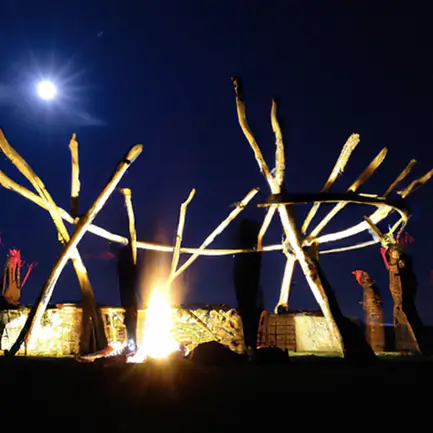Our species stands out from the animal kingdom in many ways. Some of them are obvious: we are big-brained primates who use tools and language, a social species with symbols, culture, and art. These are all artifacts of our evolution, the process by which our ancestors found adaptations that allowed them to succeed in a natural world that is often red in tooth and claw. Often, however, we think of evolution as affecting our physical bodies—changing the shape of our hominin ancestors so they could walk upright, or grow bigger brains. But evolution has other ways to act on a species, particularly in clever, social species like ours. It can shape the way we socialize and bond, the way we pass on learning and care, and even whom we love. This is why we find that one of the most remarkable adaptations our species has ever made lies in our very, very unlikely mating system: monogamy.
Monogamy is a strange word and an even stranger concept. The way we use it in our societies today to imply two people romantically linked for life is a far cry from what a scientist who actually observes primates like us would call it. Monogamy, simply put, is pair-bonding between two animals. Often it is pair-bonding with an eye towards reproduction, but it can also include animals that can’t reproduce together who form a pair-bonded social unit anyway. Perhaps the most famous example, though certainly not the only one, might be Roy and Silo, two chinstrap penguins from New York’s Central Park Zoo who formed a pair bond and even raised a chick together. There are other critical differences between what a scientist would define as a pair bond and what we commonly understand monogamy to be.
While humans tend to define monogamy as a once-in-a-lifetime pairing, with rituals and cultural rules that reinforce the idea of a lifetime bond, even the most pair-bonded of animals rarely are pair-bonded for life. Perhaps the most extreme animal monogamists on the planet are the far-flying seabirds albatrosses and petrels (all from the family Procellariiformes); almost every single pair is mated for life. However, even in these pairs, factors can intervene to disrupt the pair bond. Beyond simply losing one member of the pair, even allegedly mated-for-life albatrosses have cases of ‘extra-pair paternity’—almost 10 percent of chicks surveyed in one sample had a male parent who was not their female parent’s partner.
Humans, even those with strong cultural proscriptions against adultery, have very similar rates of extra-pair paternity—about 10 percent. While some cultures, particularly those that do not allow a great deal of female agency in choosing a partner, have slightly higher rates than others, this figure seems to be broadly the same across our species. While genetic monogamy—where two individuals breed exclusively with each other—may be elusive, even in the allegedly monogamous sea birds, social monogamy is not. Social monogamy is the type of pair bonding where the partners fulfill all the social roles needed in a pair bond without necessarily producing any genetic offspring—like Roy and Silo, tending a chick that was not their own. This suggests that it is social monogamy that is the most important part of pair bonding for many species—including our own.
Why would social monogamy benefit a species? It must offer some sort of advantage to our species, or we would not have adopted it—and we have indeed adopted it. Despite our very human flair for variety and adaptation, most societies around the world set a pair-bonded couple at the heart of how their members reproduce. Of course, there are examples of polygamy—marriage of one male to multiple females—and even polygyny—one female to many males in our wide array of cultural practices, but the vast majority of our fellow Homo sapiens will have social expectations of forming a monogamous pair bond.
So why have we evolved to have these bonds? It is not at all automatic that pair-bonds would be of adaptive value. In species that have evolved to sexually reproduce, the distribution of risk and reward for breeding behavior depends on how much each partner will need to invest in reproduction in order to produce a successful offspring. For the partner that makes the small gamete (sperm), investment costs are lower from the get-go, meaning strategies that maximize opportunities for reproduction. In fact, pair bonding is an incredibly rare phenomenon in the animal kingdom. Outside of birds, who are uncommonly fond of the state—90 percent of bird species create pair bonds—only 5 percent of animal species settle for ‘the one’ and form pair bonds. About 15 percent of primates, however, opt for pair-bonding.
Here we can start to unravel part of the mystery of the human pair bond, by examining what our other clever, social primate relatives use pair bonding for. The evolution of monogamy, or pair-bonding, has been a topic of major debates in anthropology and primatology. Most of the primate species that form pair bonds are actually quite distant from our species evolutionarily—the smaller monkey species like the marmosets, titi monkeys, and owl monkeys. Many of the original investigations of primate monogamy sought to explain the phenomenon in very Darwinian terms, looking at the advantage in genetic terms gained by reproducing monogamous pairs. In the 1970s, primatologist Sarah Hrdy suggested that pair-bonding might have evolved to be protective against infanticide because marauding male monkeys would not be motivated to harm their own genetic offspring but would be motivated to remove any offspring from a group that were not theirs.
This interpretation has been challenged in more recent times, particularly by anthropologist Holly Dunsworth. She argues that the kind of cognitive power required for a primate to understand whether offspring is genetically theirs or not is just not present in primate species. Perhaps pair-bonded species don’t have infanticide not just because the male primates are trying to maximize their genetic reproductive potential, but because primates are social animals and those male primates are simply primed to be ‘nice’ to the offspring of the females they are bonded to.
Current theories for why pair bonding exists, even though it doesn’t allow male primates to maximize their mating opportunities, follow several lines of evidence to understand what the actual adaptive benefit might be. One theory is that pair-bonding is the only way for males to keep up with females who roam over large territories; it allows them the opportunity to mate because otherwise, they wouldn’t be able to encounter any females. This is something that seems particularly applicable to the smaller monkeys like marmosets, where females hold territory.
Another theory for the evolution of pair bonding in primates looks at the reproductive benefit not just to the individual parent, in terms of the number of offspring possible, but to the effects on the next generation of having one more pair of helping hands. This looks at the net benefit to the offspring itself of having two parents provisioning it. In many species of primates, the offspring are helpless and a considerable burden on their carer. Having another pair of hands around may make the difference between growing an expensive, big-brained baby and falling out of the evolutionary race. Looking again at examples from the primate order we can see that the role of the male parent can be critical in the survival of the species—our male titi monkey will carry his offspring for the first year of their life, until they are old enough to move around on their own.
What does this mean for our own species? Well, we definitively have adopted a pair-bonded architecture—social monogamy is at the core of our societies. Why we have done so is less clear—but as more and more work is done on understanding the benefits of monogamy to a species we see that there are several factors that may have influenced our ancestors’ choices to develop such an outré mating system. In fact, monogamy in primates seems to have evolved multiple times, and for multiple reasons. Computational models that have examined the likelihood of different evolutionary explanations have used these multiple evolutionary episodes in our nearest relatives to predict that, for humans, multiple factors may have given us the monogamy we have now. Adaptations to pair bonding that ensure males meet roving females might have been a stepping stone to developing the kind of multiple-parental care that keeps something as extraordinarily demanding as a human baby alive. So while our cultural perceptions of monogamy might not fit the evolutionary reality, we can say that as a species, we are awfully fond of a pair bond.


